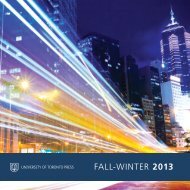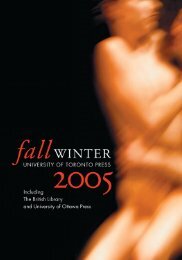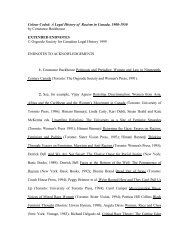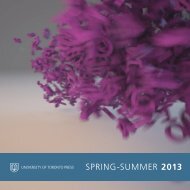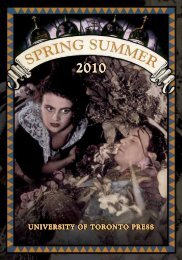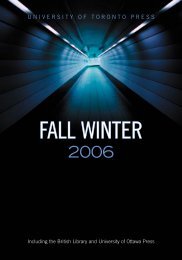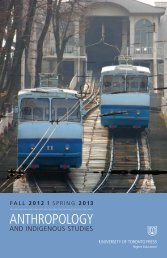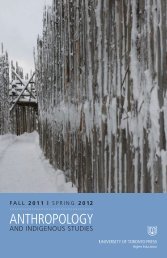Classics, Medieval & Renaissance 2012 - University of Toronto ...
Classics, Medieval & Renaissance 2012 - University of Toronto ...
Classics, Medieval & Renaissance 2012 - University of Toronto ...
Create successful ePaper yourself
Turn your PDF publications into a flip-book with our unique Google optimized e-Paper software.
LITERATURE<br />
The Persistence <strong>of</strong> Presence<br />
Emblem and Ritual in Baroque Spain<br />
Bradley J. Nelson<br />
The Persistence <strong>of</strong> Presence analyses the relationship<br />
between emblem books, containing combinations<br />
<strong>of</strong> pictures and texts, and Spanish literature in the<br />
early modern period.<br />
Bradley J. Nelson argues that the emblem was a<br />
primary indicator <strong>of</strong> the social and political functions<br />
<strong>of</strong> diverse literary practices in early modern Spain,<br />
from theatre to epic prose. In this detailed examination<br />
<strong>of</strong> emblem books, sacred and secular theatre, and<br />
Cervantes’ critique <strong>of</strong> baroque allegory in Los trabajos<br />
de Persiles y Sigismunda, Nelson connects the early<br />
history <strong>of</strong> emblematics with the drive towards cultural<br />
and political hegemony in Counter-Reformation Spain.<br />
Bradley J. Nelson is an associate pr<strong>of</strong>essor and chair<br />
in the Department <strong>of</strong> <strong>Classics</strong>, Modern Languages<br />
and Linguistics at Concordia <strong>University</strong>.<br />
‘Nelson’s approach constitutes an original contribution<br />
to Spanish emblematics with its careful analysis and<br />
thorough consideration <strong>of</strong> relevant theories.’<br />
Claudia Mesa, <strong>Renaissance</strong> Quarterly<br />
(<strong>University</strong> <strong>of</strong> <strong>Toronto</strong> Romance Series)<br />
272 pp / 16 illustrations / 6 x 9 / 2010<br />
Cloth 978-0-8020-9977-8 $55.00 (£38.99)<br />
Celestina and the Ends <strong>of</strong> Desire<br />
NEW<br />
E. Michael Gerli<br />
One <strong>of</strong> the most widely read and translated Spanish<br />
works in sixteenth-century Europe was Fernando de<br />
Rojas’s Celestina, a 1499 novel in dialogue about a<br />
couple that faces heartbreak and tragedy after being<br />
united by the titular brothel madam. In Celestina<br />
and the Ends <strong>of</strong> Desire, E. Michael Gerli illustrates<br />
how this work straddles the medieval and the modern<br />
in its exploration <strong>of</strong> changing categories <strong>of</strong> human<br />
desire – from the European courtly love tradition to<br />
the interpretation <strong>of</strong> want as an insatiable, destructive<br />
force. Gerli’s analysis draws on a wide range <strong>of</strong> Celestina<br />
scholarship but is unique in its use <strong>of</strong> modern literary<br />
and psychoanalytic theory to confront the problematic<br />
links between literature and life.<br />
E. Michael Gerli is Commonwealth Pr<strong>of</strong>essor <strong>of</strong><br />
Hispanic and Early Modern Studies at the <strong>University</strong><br />
<strong>of</strong> Virginia.<br />
‘Celestina and the Ends <strong>of</strong> Desire is a fascinating book,<br />
bringing a completely fresh approach to Fernando de<br />
Rojas’s canonical work. E. Michael Gerli’s rich and<br />
enriching theoretical approach provides a brilliant<br />
new understanding <strong>of</strong> the language and rhetoric <strong>of</strong><br />
desire.’<br />
Jesús Rodríguez-Velasco, Columbia <strong>University</strong><br />
248 pp / 8 illustrations / 6 x 9 / 2011<br />
Cloth 978-1-4426-4255-3 $55.00 (£38.99)<br />
The Poetry <strong>of</strong> Place<br />
Lyric, Landscape, and Ideology in <strong>Renaissance</strong> France<br />
FRENCH<br />
Louisa Mackenzie<br />
The sixteenth century in France was marked by<br />
religious warfare and shifting political and physical<br />
landscapes. In the face <strong>of</strong> destructive environmental<br />
change, lyric poets in <strong>Renaissance</strong> France <strong>of</strong>ten<br />
wrote about idealized physical spaces, reclaiming<br />
the altered landscape to counteract the violence<br />
and loss <strong>of</strong> the period. In The Poetry <strong>of</strong> Place, Louisa<br />
Mackenzie reveals and analyses the cultural history<br />
<strong>of</strong> French paysage through her study <strong>of</strong> lyric poetry<br />
and its connections with landscape painting,<br />
cartography, and land-use history. This unique<br />
alliance <strong>of</strong> French <strong>Renaissance</strong> studies with cultural<br />
geography and eco-criticism demonstrates that sixteenth-century<br />
poetry created a powerful sense <strong>of</strong><br />
place which continues to inform national and regional<br />
sentiment today.<br />
Louisa Mackenzie is an assistant pr<strong>of</strong>essor in the<br />
Department <strong>of</strong> French and Italian at the <strong>University</strong><br />
<strong>of</strong> Washington.<br />
‘The Poetry <strong>of</strong> Place is a stunning – and stunningly<br />
original – book that makes an enormous contribution<br />
to a number <strong>of</strong> related disciplines while opening up an<br />
entirely new field <strong>of</strong> inquiry.’<br />
Jeffrey N. Peters, <strong>University</strong> <strong>of</strong> Kentucky<br />
304 pp / 6 x 9 / 2011<br />
Cloth 978-1-4426-4239-3 $65.00 (£45.99)<br />
utppublishing.com 31




